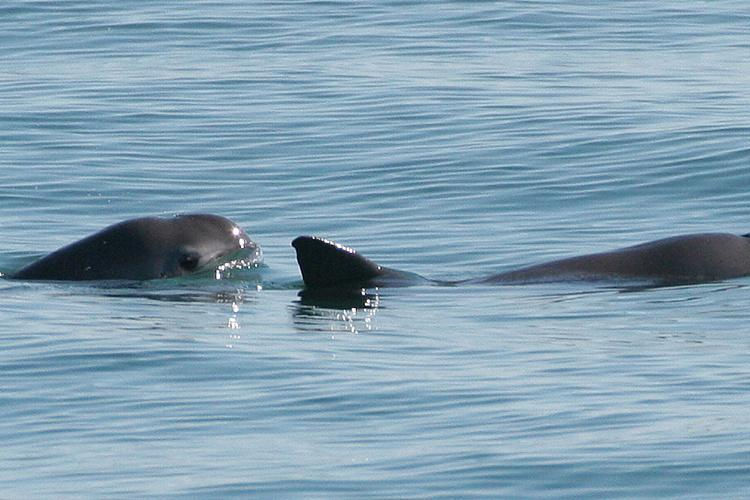Ghosts of the Pacific: The Quest for the Vaquita
- Chipco Preserve

- Jun 18
- 4 min read
Maeve Kiley
The Plight of the Cetaceans
The Gulf of California (also known as the Sea of Cortez) has a secret gem swimming through the waters.
Beneath the crystal-clear waves, 31 species of cetaceans flap their flippers and push their lean, powerful bodies up and down the canals. Whales, porpoises, and dolphins enjoy their salty home and the bountiful variety of delicious fish prepared for their consumption. Or at least, they would if cetaceans weren’t one of the most endangered families of Mammalia.
Nature has a beautiful way of designing its creations to withstand the natural obstacles they will face. However, nature did not take into consideration humanity’s hunger for reckless expansion. Oil spills, pollution, overfishing, waste dumping, and numerous other human-made catastrophes have decimated cetacean populations, as well as those of other marine life.
With ocean levels rising and food populations going down, Cetaceans must navigate challenges they weren’t built for. The IUCN Red List of Threatened Species estimates that roughly 1 in 4 cetacean species are near extinction, with 19 of those species and subspecies classified as ‘Critically Endangered.’ The IUCN Cetacean Specialist Group reports that the assessed conservative status of 20% of the cetaceans has plummeted from 2008 to 2021, with only three moved into categories of lesser threat.
But no cetacean has felt the effects of human influence more than the Vaquita.

The Panda of the Sea
Provided with the humorous Ursidea nickname due to the distinctive black marks around their eyes and smiling-curved “lip liner,” the Vaquita is the smallest cetacean. Their native home is Mexico, where they earned their name “Vaquita,” which translates to “little cow,” while their scientific name, Phocoena sinus, means “porpoise of the gulf.”
Measuring only 5 feet in length and possessing no distinctive beak, this cherubic cetacean is known for its shy personality. Their bodies may be small, but they are mighty, with a rounded head prepared to charge forward through the strongest of waves.
Eye-witness reports are sparse because Vaquitas are not known for performing acrobatics at the surface, unlike their dolphin peers, nor are they known for traveling in large groups like their whale cousins. The Vaquitas’ dorsal fin is taller and broader than that of most porpoises, and their unique markings, as well as their essential role as both predator and prey in the Pacific Ocean, make them a special species of aquatic mammals.
Unfortunately, they have one thing in common with their Cetacean peers: endangerment. Human corporations’ inconsiderate nature and bulldozer method of business have led to their suffering.
Bycatches and Gillnets
The commercial and recreational fishing industries in the United States generate $321 billion in sales, according to the American Sportfishing Association. It is safe to say that it is a massive business, but not a victimless one.
Unfortunately, many fishing corporations have taken unethical approaches to drumming up profit. Gillnets are one of those methods.
Gillnets are walls of netting that hang in the water and are commonly used in the Bay of California for big business fish. Illegal fishing is another contender, with gillnets, where Totaba fish hunting is highly profitable on the black market. Vaquitas get caught in the gillnets’ bycatch and drown.
In 2016, there were an estimated 30 Vaquitas left, with 11 of those Vaquitas perishing due to Gillnets by March 2020, according to the Marine Mammal Commission.
As of 2025, there are fewer than 10 Vaquitas still alive.

Preservation
With such dire numbers, non-profits and marine education groups are scrambling to rescue these pained porpoises.
The Porpoise Conservation Society has launched a global initiative to educate and eradicate public apathy towards the plight of this porpoise. Donations are always accepted, as well as an “Adopt a Vaquita” program to adopt the smallest of the cetacean species symbolically.
The National Marine Mammal Foundation founded Operation Esperanza. The name “Esperanza” translates to “Hope” in Spanish, for they put their hope into action. Community and collaboration are their core values, as evidenced by newsletters, easily accessible educational materials, published NMMF journals, and donation opportunities to help study, sympathize with, and support the Vaquita.
Many other organizations, communities, clubs, and social media groups are fighting for the Vaquita. Passionate about porpoises, these communities fight against the injustices facing marine life and call for more fruitful, fair fishing practices.
The Panda of the Sea is nearing the point of no return. It will be a horrific experience for future generations to see the Vaquita in a picture book and ask their parents, “What is that?” Their parents’ response: “That was a Vaquita, but they died out because people were reckless and did not care.”
But humans should care because the ocean does not belong just to us. It belongs to a complex, masterfully woven ecosystem full of powerful, unique creatures that are worthy of love and life.
So, love the Vaquita and spread the word of their struggles. The Vaquita may be shy, but they are porpoises with a purpose.
Sources
Franks, E. (2019, May 29). Saving the Vaquita. National Marine Mammal Foundation. https://nmmf.org/our-work/conservation-medicine/vaquita-conservation/
Pacific, A. of the. (n.d.). Vaquita. Aquarium of the Pacific - A Non-profit Organization. https://www.aquariumofpacific.org/onlinelearningcenter/species/vaquita#:~:text=Native%20to%20Mexico%2C%20their%20scientific,%2C%20cochito%2C%20and%20vaquita%20marina.
Red List Status of Cetaceans. IUCN SSC Cetacean Specialist Group. (n.d.-a). https://iucn-csg.org/red-list-status-of-cetaceans/#:~:text=The%20proportion%20of%20threatened%20cetaceans,into%20categories%20of%20lesser%20threat.
Sportfishing in America. (n.d.-d). https://asafishing.org/wp-content/uploads/2021/03/Sportfishing-in-America-economics-report.pdf
The IUCN Red List of Threatened Species. IUCN Red List of Threatened Species. (n.d.). https://www.iucnredlist.org/resources/brauliketal2023
Vaquita. Marine Mammal Commission. (2024, February 5). https://www.mmc.gov/priority-topics/species-of-concern/vaquita/#:~:text=Abundance%20and%20Trends&text=Eleven%20dead%20vaquitas%20were%20found,was%20directly%20attributed%20to%20gillnets.
Vaquitas: Facts, Habitat, diet, and conservation status. IFAW. (n.d.). https://www.ifaw.org/animals/vaquitas#:~:text=Known%20for%20their%20elusive%20nature,than%20their%20larger%20cetacean%20relatives.




Comments